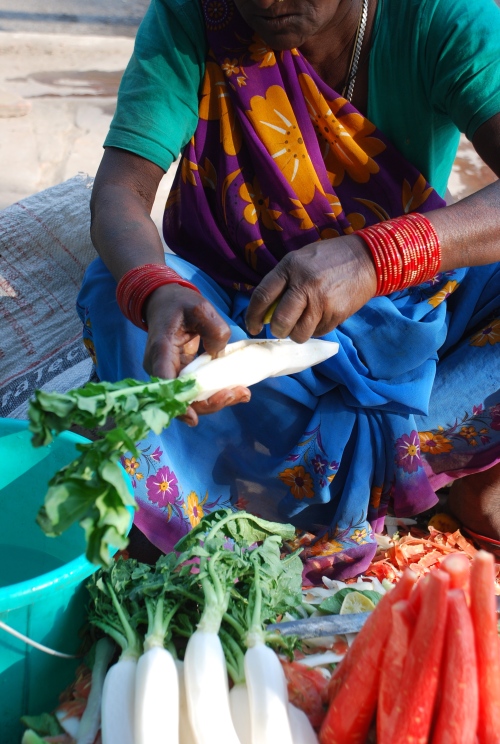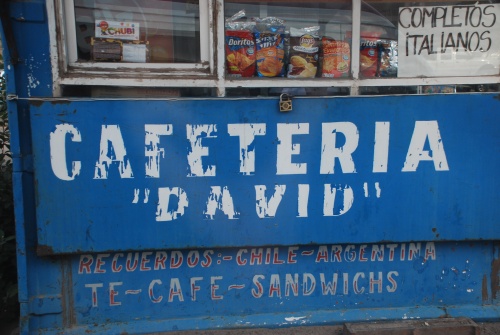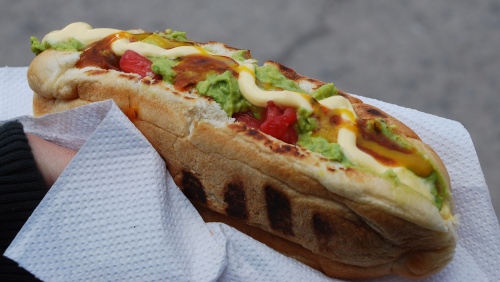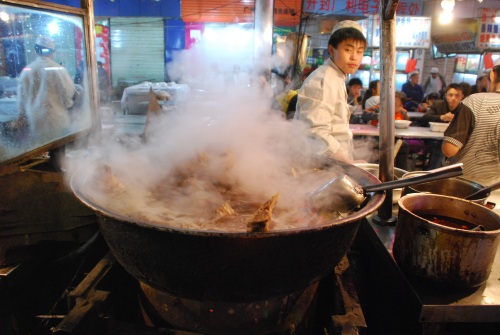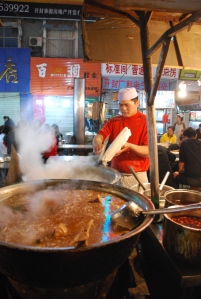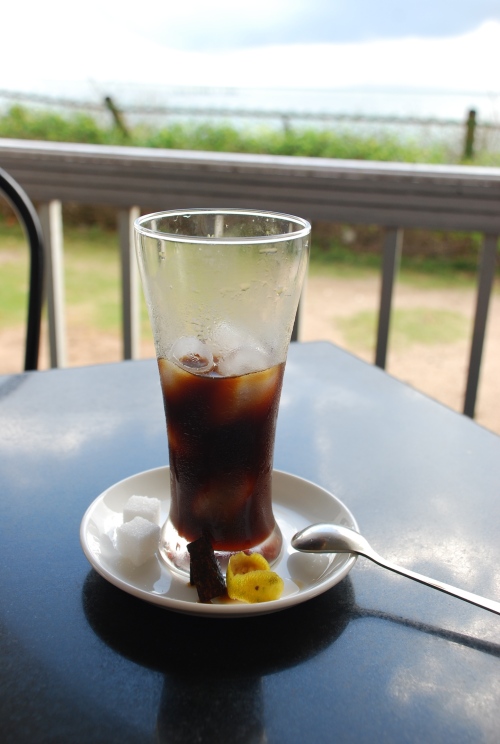
Even though we’re in India, and have been eating copious quantities and watching sport (cricket!) each day, we couldn’t let the fourth Thursday in November go by without doing more of the same.
So to thank our friends, Michael, Mina and Munu Anthony, who’d treated us to a week of deliciously home cooked meals, evenings out, restaurant visits and Bengali sweets, we decided to host Thanksgiving in our borrowed flat.
We’d already cooked one meal, a simple chicken (no ground beef in India) bolognaise and learned that no matter how tasty the dish, it wouldn’t fly with our Bengali friends without some amount of pique—the Anthonys chewed on fiery green chilies in between each bite of bolognaise! So we spiced up traditional Thanksgiving fare with chili, cayenne, turmeric and a myriad of other spices.
- Spiced Sweet Potato Soup
- Dry-fried Sichuanese-style Green Beans
- Roast Cauliflower and Pumpkin
- Chicken Onion Curry
 The day began with a trip to the local market, where Mina haggled over the price and quality of each ingredient on our list, walking us from one end of the market to the other, ensuring our potatoes, cauliflower and chilies were the best available. We bought our veggies and then perused the fish market as Mina needed fresh fish for lunch. It was the only fish market I’ve visited where the fish smells fresh and oceany rather than pongingly fishy.
The day began with a trip to the local market, where Mina haggled over the price and quality of each ingredient on our list, walking us from one end of the market to the other, ensuring our potatoes, cauliflower and chilies were the best available. We bought our veggies and then perused the fish market as Mina needed fresh fish for lunch. It was the only fish market I’ve visited where the fish smells fresh and oceany rather than pongingly fishy.
The fish mongers sat on tables with two-foot-long fixed knives jutting up in front of them and their fish laid out to the side. As they sliced the fish as per their customer’s instructions, they dribbled the fish blood over the other fish to enhance the flavor of the meat as it lay waiting to be bought.
After buying fish steaks we walked to the grains, where dal and rice were stacked in 50-pound, burlap sacks. Mina walked to the corner of a rice stall and waited as though doing some undercover deal, and within moments, a guy wearing a blood-covered shirt approached Mina; she spoke rapidly to him in Bengali, he asked a few questions, which she answered, and then we were off. Did we just buy rice? Contract a murder? We continued our shopping and about 15 minutes later returned to the edge of the rice and grain stall. The man met us again with a bag of bloodied chicken bits, slaughtered, cleaned and cut to our specifications! We returned to the house by rickshaw and began our cooking.
Spiced Sweet Potato Soup

Serves 8-10
- 6 cups chicken stock either store bought or for home-made: 1 onion (we used a red onion as that was the only kind available), veg ends, 2 lbs chicken backs and any other “extra” bits
- 3 lbs sweet potatoes, peeled and chopped into 1/2 chunks
- 1 large onion, finely chopped
- 2 cloves of garlic, finely chopped
- 1 1/2 T garam masala * We used Shahi brand garam masala with is a combination of clove, cinnamon, nutmeg, small cardamom, big cardamom, black pepper, taj, and paprika. But there are many variations and many recipes out there.
- 1 T chili powder
- Salt and pepper to taste
- 2 cups milk
- Cream for garnish
- Vegetable oil
We divided the chicken, so fresh it was still warm, into wobbly, boney bits (for stock) and meaty bits for our main meal.
For stock: Heat oil and fry up diced onion and garlic until they release their juices—3-5 minutes. Add chicken bits and brown. The browning of the chicken will determine the end richness of the stock so don’t move too quickly here—10-15 minutes. Once sufficiently brown, add 1 t salt and any vegetable trimmings you have—we used green bean ends and cauliflower trimmings—cover with water and simmer for about an hour until the stock is rich in flavor and strain.
In a fresh pan, heat 2 T of oil over medium-high heat and fry the finely chopped onion and garlic until they begin to brown. Add the spices and cook gently to increase their flavor. Add potatoes and cover with stock. Simmer until potatoes are tender, about 20 minutes.
Transfer potatoes to a blender with a slotted spoon and puree in batches with broth. Adjust amount of broth (you will not need all of it!) to create a thick, soup-like consistency. Depending on the starchiness of the potatoes this will vary greatly.
Return to pot and add 2 cups of milk and bring to simmer. Season with salt and pepper and serve with a swirl of fresh cream.
*We were only able to find white sweet potatoes in India. The flavor of the soup was still divine and the garam masala brought about hints of pumpkin pie; however, the sludgy grey color left a bit to be desired.
Dry-Fried Sichuanese Green Beans
I love Fuscia Dunlop’s Dry-Fried Green Bean recipe from her brilliant cookbook, Land of Plenty, as seen on Leite’s Culinaria. However, with the constraints of the local Kolkata market, we needed to improvise. Also, we wanted a milder dish so as not to compete with our main spicy chicken dish. We’d been seduced by the smell of the Sichuanese peppercorns in a market in Xian and had bought a bag of them all the way from China (and yes, my scent du jour is eau de peppercorn!) So this is a milder dish than Dunlop’s (and not authentically Chinese) but it maintains that addictive “mala” tang and allows the floral Sichuan pepper corn to really take the lead!
- 1 lb green beans, trimmed
- 2 T oil
- 1 1/2 T Sichuanese peppercorns
- 1/2 red pepper flakes
Dry roast the Sichuanese peppercorns over a medium heat until they begin to color. Remove from heat and crush coarsely.
Heat oil in a frying pan and stir fry beans over a medium-high heat until they begin to pucker. The beans will be tender but firm. Add crushed peppercorns, red pepper flakes and season with salt and pepper.
Our main course was from Great Indian Dishes, by Rafi Fernandez:
Chickens in Spicy Onion (Murgh Do Piyaza)
Serves 4-6
Ingredients
-
3lbs chicken jointed and skinned
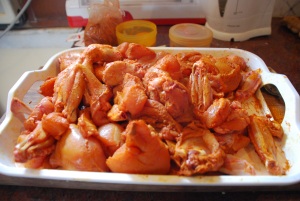
-
½ t turmeric
-
½ t chili powder
-
Salt, to taste
-
4T oil
-
4 small onions, finely chopped
-
6 oz (2 bunches) of fresh coriander (cilantro) leaves, coarsely chopped
-
1 piece fresh ginger, 2 inches long, finely grated
-
2 green chilies, finely chopped
-
2 t cumin seeds, dry-roasted
-
1/3 cup plain yoghurt
-
1/3 cup heavy cream
-
½ t cornstarch
Rub the chicken joins with the turmeric, chili powder and salt. Heat the oil in a frying pan and try the chicken pieces without overlapping until both sides are browned. Remove and keep warm.
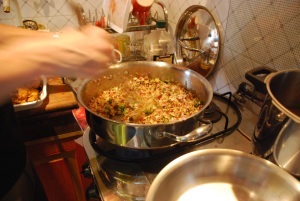 Reheat the oil and fry 3 of the chopped onions and 5 oz of the coriander (cilantro), half the ginger, the green chilies and the cumin seeds until the onions are translucent. Return the chicken to the pan with any juices and mix well. Cover and cook gently for 15 minutes.
Reheat the oil and fry 3 of the chopped onions and 5 oz of the coriander (cilantro), half the ginger, the green chilies and the cumin seeds until the onions are translucent. Return the chicken to the pan with any juices and mix well. Cover and cook gently for 15 minutes.
Remove the pan from the heat and allow to cool a little. Mix together the yoghurt, cream and cornstarch and gradually fold into the chicken mixing well.
Return the pan to the heat and gently cook until the chicken is tender. Just before serving, stir in the reserved onion, coriander and ginger. Season with salt and pepper and serve hot.

And in true Indian fashion, the feast wouldn’t have been complete without the finery. Both David and I were dressed up, painted, and adorned in traditional Indian clothes. Me, in an orange, sequin-encrusted saree and David in a traditional Punjabi top.




